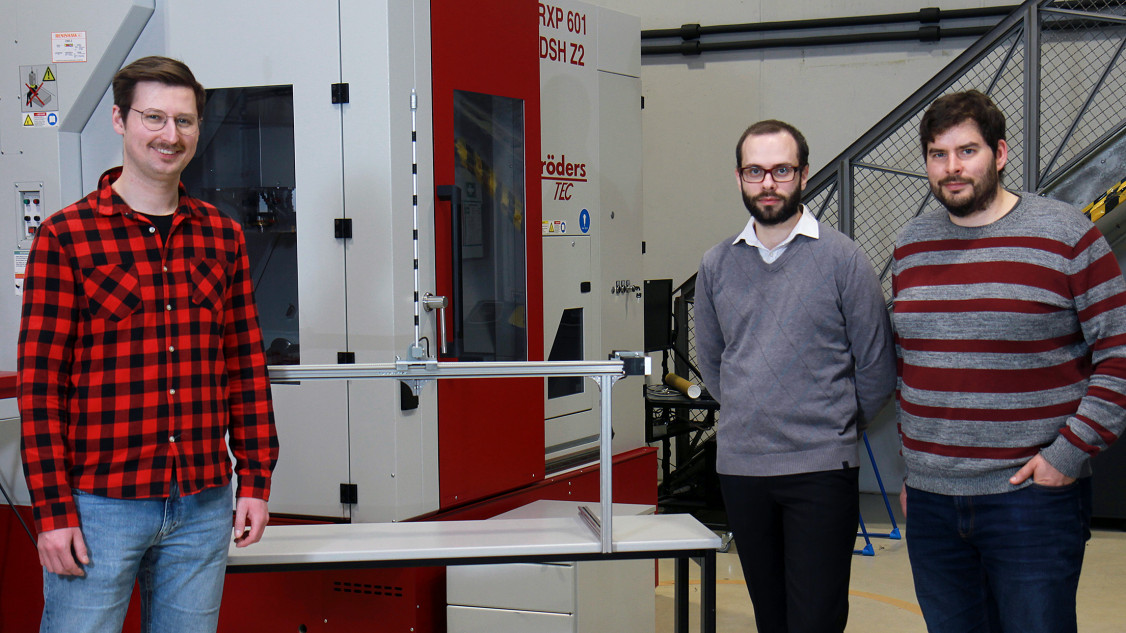
The digitalisation of production opens up many advantages for companies, including greater flexibility in production combined with greater resistance to disruptions. The future 6G mobile communications standard should finally translate this potential into market-orientated communication solutions. At RPTU, a team of researchers is working on concepts for wireless interconnectivity via networks-in-networks approaches, i.e. specialised "sub-networks". A classic machine tool, a CNC milling machine, serves as a use case. They will be presenting their research work at the Hannover Messe from 22 to 26 April at the joint stand of the 6G platform - stand H06, hall 014.
"To remain competitive, companies need an adaptable manufacturing environment. This is the only way they can manufacture customised products efficiently and react quickly to disruptions such as supply chain bottlenecks," says Jan Mertes, research associate at the Chair of Production Engineering and Industrial Organisation at RPTU. Manufacturing can achieve this level of performance through digitalisation and a high level of interconnectivity between the various machines and devices. Networking enables new, intelligent solutions for production control, planning and system interaction.
Existing wireless solutions do not fulfil these requirements or are not compatible with other communication architectures due to their proprietary design. "The control of production machines places extremely high demands on latency in particular, i.e. the time it takes for signals to travel from the transmitter to the receiver," says Daniel Lindenschmitt, research associate at the Department of Radio Communication and Navigation, who is researching 6G concepts together with Mertes. "It's not just about how long the delay is. The arrival time of the signal must also be predictable and therefore reliable. In other words, our research work is concerned with what is known as 'ultra-reliable and low-latency communication'. This vision should finally become reality with the 6G mobile communications standard."
The idea: a network-in-network system
The two researchers are using wireless networks-in-networks (NiN) for their concept. The idea behind this is that specialised architectures that are tailored to the needs of industrial use cases dock onto the overarching 6G overall architecture - a segmented approach, so to speak.
Lindenschmitt and Mertes are combining their basic research into NiN, also known as underlay networks, with the development of a demonstrator: this is a CNC milling machine that is controlled in a closed control loop - a classic and highly complex use case. "Until now, the hardware of control components has been connected to production machines and systems by cable. Our concept now enables virtualisation of the milling machine with the necessary low latency and reliability of signal transmission."
At the Hannover Messe, the two researchers will illustrate the different properties of networks using a simple control technology example: an inverted pendulum that is mounted in an oscillating position. In order for it to remain in an upright position, reliable and extremely fast signal transmission is required. "This allows interested parties to directly experience the advantages of networks-in-networks concepts and what we want to achieve with our 6G research," summarises Lindenschmitt.

Sub-project in the "Open6GHub"
The project is part of the "Open6GHub", a project funded by the Federal Ministry of Education and Research (BMBF). The coordinator is Professor Dr Hans D. Schotten, Head of the Chair of Radio Communication and Navigation at RPTU and Head of the Intelligent Networks research department at the German Research Centre for Artificial Intelligence (DFKI). The Chair of Production Engineering and Industrial Organisation at RPTU, headed by Professor Dr.-Ing. Jan C. Aurich, is also contributing its expertise. In addition to RPTU and DFKI, other universities and research institutes are also involved in the Open6GHub.
In the research network, the partners want to contribute to the development of an overall 6G architecture and also launch end-to-end solutions in the following areas, among others: Extended network topologies with highly agile so-called organic networking, security and resilience, Thz and photonic transmission methods, sensor functionalities in the networks and their intelligent utilisation and further processing and application-specific radio protocols. Along the way, the researchers are open to dialogue and cooperation: "We are looking for an early and interactive dialogue with the public and are also ready for cooperation with industry and users," says Schotten. "To this end, we will install open labs and open experimental fields. Last but not least, we want to promote an open innovation system by involving SMEs and start-ups and their results."

